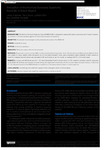Evaluation of the Multiple Sclerosis Spasticity Scale 88: A Short Report
| dc.contributor.author | Freeman, Jennifer | |
| dc.contributor.author | Gorst, T | |
| dc.contributor.author | Ofori, J | |
| dc.contributor.author | Marsden, Jonathan | |
| dc.date.accessioned | 2021-10-22T12:50:37Z | |
| dc.date.issued | 2019-01-16 | |
| dc.identifier.issn | 1179-5727 | |
| dc.identifier.issn | 1179-5727 | |
| dc.identifier.uri | http://hdl.handle.net/10026.1/18159 | |
| dc.description.abstract |
Background: The Multiple Sclerosis Spasticity Scale 88 (MSSS-88) is designed to capture the patient experience and impact of spasticity, but there is limited evaluation against clinician-rated measures of spasticity. Objective: To evaluate the convergent validity and responsiveness of the MSSS-88. Design: Longitudinal study. Setting: University Laboratory. Subjects: Thirty-four people with multiple sclerosis. Methods: People with multiple sclerosis (MS; n = 34) completed the self-reported 12-item Multiple Sclerosis Walking Scale, Multiple Sclerosis Spasticity Scale, Barthel Index alongside the clinician-rated Ashworth Scale, and a laboratory-based measure of ankle spasticity. Spasticity measure responsiveness was evaluated in 20 participants at two time points, an average of 8.75 ± 3.8 months apart. Results: In people with MS (mean age 55.1 ± 8.1 years; Expanded Disability Scale range 4.5-7.0), spasticity symptom specific subscales of the MSSS-88 (stiffness and spasms) showed strong and significant correlations with the clinician-rated Ashworth Scale ( r = 0.52-0.53; P < .01). Responsiveness of the MSSS-88 was comparable to a laboratory-based measure of ankle spasticity. Conclusions: Our findings lend additional support to the convergent validity of this measure. | |
| dc.format.extent | 1-4 | |
| dc.format.medium | Electronic-eCollection | |
| dc.language | en | |
| dc.language.iso | en | |
| dc.publisher | SAGE Publications | |
| dc.subject | multiple sclerosis | |
| dc.subject | outcome assessment | |
| dc.subject | psychometrics | |
| dc.subject | spasticity | |
| dc.title | Evaluation of the Multiple Sclerosis Spasticity Scale 88: A Short Report | |
| dc.type | journal-article | |
| dc.type | Journal Article | |
| plymouth.author-url | https://www.ncbi.nlm.nih.gov/pubmed/34497457 | |
| plymouth.volume | 8 | |
| plymouth.publication-status | Published | |
| plymouth.journal | Rehabilitation Process and Outcome | |
| dc.identifier.doi | 10.1177/1179572718823510 | |
| plymouth.organisational-group | /Plymouth | |
| plymouth.organisational-group | /Plymouth/Faculty of Health | |
| plymouth.organisational-group | /Plymouth/REF 2021 Researchers by UoA | |
| plymouth.organisational-group | /Plymouth/REF 2021 Researchers by UoA/UoA03 Allied Health Professions, Dentistry, Nursing and Pharmacy | |
| plymouth.organisational-group | /Plymouth/Research Groups | |
| plymouth.organisational-group | /Plymouth/Research Groups/FoH - Applied Parkinson's Research | |
| plymouth.organisational-group | /Plymouth/Research Groups/Institute of Health and Community | |
| plymouth.organisational-group | /Plymouth/Users by role | |
| plymouth.organisational-group | /Plymouth/Users by role/Academics | |
| plymouth.organisational-group | /Plymouth/Users by role/Researchers in ResearchFish submission | |
| dc.publisher.place | England | |
| dcterms.dateAccepted | 2018-11-12 | |
| dc.rights.embargodate | 2021-10-23 | |
| dc.identifier.eissn | 1179-5727 | |
| dc.rights.embargoperiod | Not known | |
| rioxxterms.versionofrecord | 10.1177/1179572718823510 | |
| rioxxterms.licenseref.uri | http://www.rioxx.net/licenses/all-rights-reserved | |
| rioxxterms.licenseref.startdate | 2019-01-16 | |
| rioxxterms.type | Journal Article/Review |


